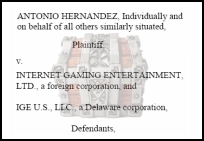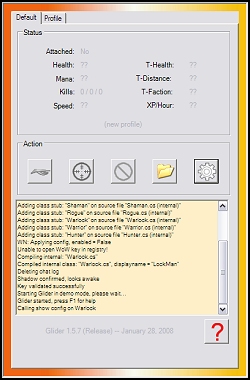Hernandez v. IGE Settles, IGE U.S. Confirms It Will Not “Engage in the Selling of WoW Virtual Property or Currency” for Five Years; Class Action Still Possible
August 27th, 2008 by Benjamin Duranske
 According to a stipulation (.pdf) filed with the court, World of Warcraft player Antonio Hernandez has settled his dispute with Internet Gaming Entertainment U.S. (“IGE U.S.”) securing an agreement that IGE U.S. “will not engage in the selling of World of Warcraft virtual property or currency (commonly referred to as “gold,” “gold farming,” “real money trade” or “RMT”) for a period of five (5) years.” However, this agreement likely will not impact IGE.com’s business model significantly (and indeed, World of Warcraft gold remains for sale at IGE.com) because IGE U.S. “has denied engaging in any improper activities,” and says it does not operate IGE.com.
According to a stipulation (.pdf) filed with the court, World of Warcraft player Antonio Hernandez has settled his dispute with Internet Gaming Entertainment U.S. (“IGE U.S.”) securing an agreement that IGE U.S. “will not engage in the selling of World of Warcraft virtual property or currency (commonly referred to as “gold,” “gold farming,” “real money trade” or “RMT”) for a period of five (5) years.” However, this agreement likely will not impact IGE.com’s business model significantly (and indeed, World of Warcraft gold remains for sale at IGE.com) because IGE U.S. “has denied engaging in any improper activities,” and says it does not operate IGE.com.
According to a declaration filed by IGE’s sole officer, Brock Pierce (.pdf) “IGE U.S. consists solely of its stock holdings in Affinity Media,” a company IGE U.S. sold all of its assets to on May 25, 2007, six days before this lawsuit was filed. Other U.S. IGE assets, including its RMT business, had previously been sold to a company called Atlas Technology Group. Pierce says that “IGE U.S. does not own, operate, or administer … IGE.com.”
The lawsuit will be dismissed “with prejudice” (meaning that it cannot be refiled) only with respect to the named plaintiff, Antonio Hernandez. Any of the remaining members of the proposed class (the other ten million or so people who play World of Warcraft) are free to refile the suit against other defendants, such at Atlas and or Affinity, if they want to.
For the full background of this case, see our complete coverage. In brief, plaintiff sued IGE U.S. on behalf of essentially all World of Warcraft players on the grounds that IGE, by farming gold, spamming chat, camping spawns, and generally diminishing the World of Warcraft experience, allegedly prevented players from receiving the full benefits Blizzard intended them to receive as third party beneficiaries of Blizzard’s Terms of Use and End User License Agreement.
Commentary
Bottom line? There could have been a better result here, but no harm, no foul. The judge never ruled on class certification, so any other World of Warcraft player is free to pursue this claim against Atlas (or Affinity, or whoever ultimately ended up running the RMT business that operates at IGE.com) or any other RMT provider, and Hernandez did get an agreement from IGE U.S. not to engage in RMT. That maybe doesn’t make a lot of practical difference, but has some symbolic value as it puts everyone on notice that this kind of claim could go further than it did here.
Given that IGE U.S. was the only company named in this suit, this is really the best possible outcome. Notably, it’s also the outcome that Hernandez and his lawyer, Rich Newsome, said they were seeking originally, at least in general terms. In an interview at The Escapist last summer, Newsome said:
Guys like Tony [Hernandez, the plaintiff] have paid their $15 for some entertainment, and IGE is polluting that entertainment. It’s kind of like, if someone pays for a ticket to go see a movie, and if someone else comes in behind them and kicks their seat, you can get them to stop doing that. We’re just trying to get IGE to stop kicking the seats. This is not unlike other consumer complaints where someone has paid for a service, and someone else is interfering with it. It’s really very simple. We want to make IGE stop kicking the seat – stop polluting the service that’s been paid for. We’re going to get an injunction. We pleaded for money damages, but the No. 1 goal that we really want is to make them stop.
 Personally, I’d have loved to see this go farther (and I suspect Newsome would have too) but it simply wasn’t going to happen. The problem here is that the company that was sued (IGE U.S.) wasn’t really the right target for this lawsuit. That’s just how it goes in lawsuits sometimes; there is really no way that Hernandez or his attorney could have known IGE’s corporate structure when the suit was filed — a mere six days after IGE sold all of its assets to Affinity Media in a private transfer and less than two months after the transfer of the RMT business to Atlas in a similar private deal. The near-constant changes to IGE’s corporate structure and ownership are complex enough that there’s a lengthy article at MMOBux devoted to the subject, and after close to a year of following the company, I still don’t entirely understand who owns and runs it.
Personally, I’d have loved to see this go farther (and I suspect Newsome would have too) but it simply wasn’t going to happen. The problem here is that the company that was sued (IGE U.S.) wasn’t really the right target for this lawsuit. That’s just how it goes in lawsuits sometimes; there is really no way that Hernandez or his attorney could have known IGE’s corporate structure when the suit was filed — a mere six days after IGE sold all of its assets to Affinity Media in a private transfer and less than two months after the transfer of the RMT business to Atlas in a similar private deal. The near-constant changes to IGE’s corporate structure and ownership are complex enough that there’s a lengthy article at MMOBux devoted to the subject, and after close to a year of following the company, I still don’t entirely understand who owns and runs it.
Hernandez might have been able to add Affinity Media and Atlas, but the deadline for adding parties apparently passed before it became clear that IGE U.S. wasn’t really the right target. Moreover, another original party to the suit, IGE Ltd. (a Hong Kong company), could not be served with the lawsuit in time, and so had to be dropped as a party. Sometimes, that’s just how it goes.
I asked Rich Newsome, Hernandez’s attorney, to comment, but he said (understandably) that he had to limit his commentary to statements in a fairly sparse joint press release about the settlement (.pdf) and previous interviews.
 For me, this is still a pretty cool case because it highlighted a novel legal theory that we have not, I suspect, seen the last of.
For me, this is still a pretty cool case because it highlighted a novel legal theory that we have not, I suspect, seen the last of.
Here’s how it breaks down: Hernandez claimed that gold farmers diminished the value of his (and everybody’s) World of Warcraft play experience, something people shell out around $15 a month to enjoy. The theory he was suing under was that every gold farming company has to agree not to farm gold, spam chat, and do all of the other bad things associated with RMT companies, and they break that agreement all the time. The point of that agreement, Hernandez argued, was to provide him and the other players a clean game experience free of RMT.
The claim was a semi-longshot, but I think it had a chance. If Blizzard had weighed in with a declaration to the court that Hernandez and the rest of the class were “intended third party beneficiaries” of the EULA and TOU — and I suspect that it might have, given its public support of the suit — and a few other things fell into place, I think the plaintiffs would have had a real shot.
We’re not talking about a lot of money on an individual basis but even a month or two worth of game fees per player would be enough to put any RMT company out of business when you are talking about a class of 10 million potential plaintiffs. This suit turned out to not be the right one to test this theory, but it exposed a potential avenue for future claimants, and players owe Hernandez a debt of gratitude for taking the first steps, even if the result doesn’t directly change the RMT landscape significantly.
Related Posts on Virtually Blind
- Hernandez v. IGE Update: Brock Pierce Declaration and Hernandez Motion to Compel Filed: "There are two new developments in Hernandez v. IGE. First, IGE has..." (1 comments)
- New Lawyers Now Defending Virtual Property Company IGE in Hernandez Class Action Suit: "Virtual property company Internet Gaming Entertainment (IGE) has..." (0 comments)
- Hernandez and IGE “Diligently Pursuing Settlement Negotiations,” So What About the Other 10m Users? [Updated July 21, 2008]: "VB has obtained a joint motion (.pdf) filed July 11 in the not-yet..." (4 comments)


 Late last month, World of Warcraft creator Blizzard
Late last month, World of Warcraft creator Blizzard  MDY’s new brief argues, among other things, that “a district court should only include injunctive terms that have a common sense relationship to specific case’s needs, and the conduct for which the defendant has been held liable.” MDY says that some of the restrictions Blizzard seeks “punish MDY rather than protect Blizzard from potential infringers.”
MDY’s new brief argues, among other things, that “a district court should only include injunctive terms that have a common sense relationship to specific case’s needs, and the conduct for which the defendant has been held liable.” MDY says that some of the restrictions Blizzard seeks “punish MDY rather than protect Blizzard from potential infringers.” Blizzard, for its part, argues that the remedies it seeks are necessary to prevent further infringement. Blizzard says:
Blizzard, for its part, argues that the remedies it seeks are necessary to prevent further infringement. Blizzard says: I’ve got a few extra
I’ve got a few extra  In the paper, Palyan sets forth a “reasonable avatar” standard as a way of determining what should constitute ‘highly offensive’ intrusion and a ‘reasonable expectation of privacy’ in a virtual world. From Common Law Privacy in a Not So Common World:
In the paper, Palyan sets forth a “reasonable avatar” standard as a way of determining what should constitute ‘highly offensive’ intrusion and a ‘reasonable expectation of privacy’ in a virtual world. From Common Law Privacy in a Not So Common World: